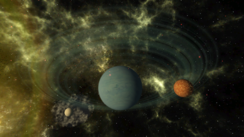
|
This wiki is closed in favour of the new wiki. Information shown is likely to be very out of date. |
Difference between revisions of "Planet Avers"
From Discovery Wiki
Jump to navigationJump to search (Created page with "{{Version|4.91}} {{Planet Infobox | name = Planet Avers | image = Planet Avers.png | owner = | system = Zurich | sector = 7E | house = | population = 0 | docking = No |...") |
m (category added) |
||
| Line 15: | Line 15: | ||
| escape_velocity = 64,16 km/sec | | escape_velocity = 64,16 km/sec | ||
}} | }} | ||
| − | As the sole gas giant of the [[Zurich]] system, Avers is accompanied by two moons, the icy Cresta and the volcanic [[Ramsen]], as well as an astouningly extensive sytem of rings. The range and dispersion of the size of the fragments making up the rings suggest the two moons used to have other siblings in the distant past, although astronomers don't exclude the possibility of the formation of new ones in the future either. | + | As the sole gas giant of the [[Zurich]] system, Avers is accompanied by two moons, the icy [[Cresta]] and the volcanic [[Ramsen]], as well as an astouningly extensive sytem of rings. The range and dispersion of the size of the fragments making up the rings suggest the two moons used to have other siblings in the distant past, although astronomers don't exclude the possibility of the formation of new ones in the future either. |
[[Category: Border Worlds]] | [[Category: Border Worlds]] | ||
| + | [[Category: Zurich]] | ||
Latest revision as of 14:09, 18 February 2019
| Planet Avers | |
| Location | 7E, Zurich |
| Technical information | |
| Docking | No |
| Terrain | N/A |
| Diameter | 152,384 km |
| Mass | 2.35 x 10e27 kg |
| Temperature | N/A |
| Escape velocity | 64,16 km/sec |
As the sole gas giant of the Zurich system, Avers is accompanied by two moons, the icy Cresta and the volcanic Ramsen, as well as an astouningly extensive sytem of rings. The range and dispersion of the size of the fragments making up the rings suggest the two moons used to have other siblings in the distant past, although astronomers don't exclude the possibility of the formation of new ones in the future either.
